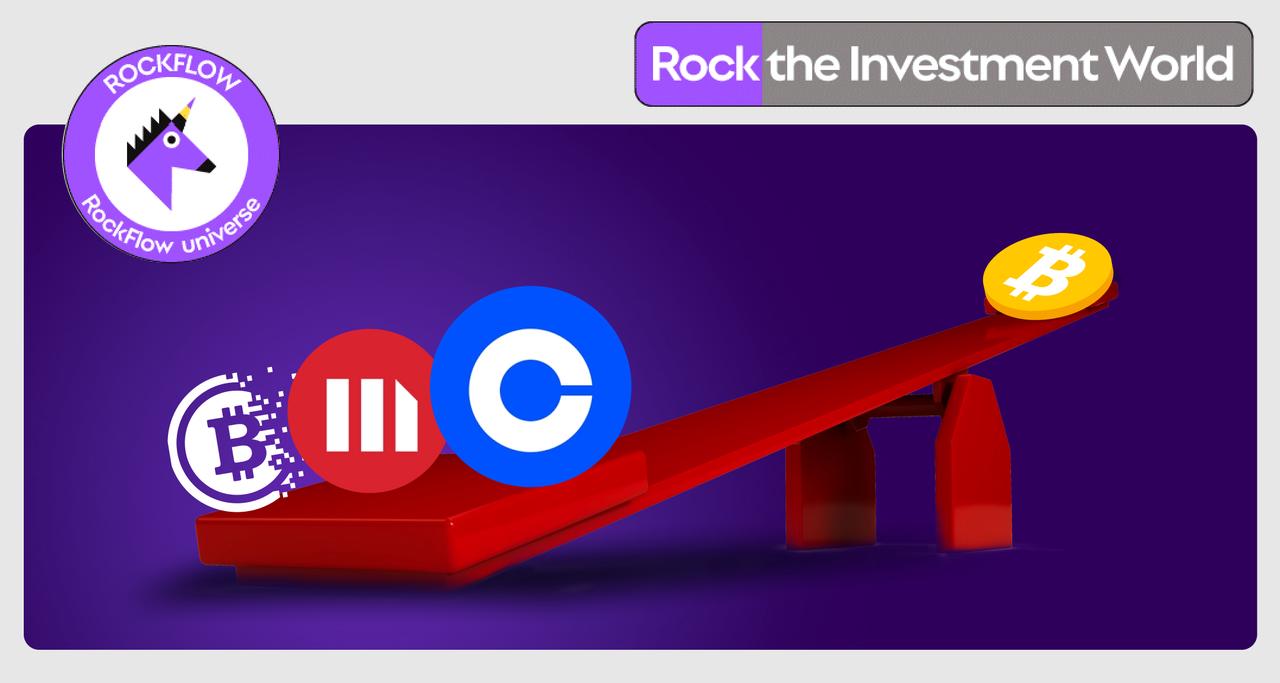
하이라이트:
역사적으로 블록 보상을 반감하면 전년도 비트코인 가격에 큰 변동이 발생합니다. 이전 세 번 모두 비트코인 가격이 크게 상승했습니다. 유사한 리듬을 따르면, 2024년 말까지 비트코인은 10만 달러를 돌파할 가능성이 높습니다.
- 최신 암호화폐 불장은 2022/23년에 시작되었으며, 비트코인이 사상 최고치를 돌파한 지 며칠 후였지만, 이것은 분명히 끝이 아닙니다. 더 나은 규제 명확성과 더 성숙한 전통적인 투자 상품, 그리고 더 많은 전통적인 자금 유입의 혜택을 받아 비트코인은 현재 글로벌 인플레이션 환경에서 자본이 추구하는 이상적인 자산 클래스가 되고 있습니다. 비트코인 현물 ETF 승인 이후, IBIT 및 기타는 2개월 만에 거의 40% 상승했습니다. 이번 불장에서 암호화폐 거래, 비트코인 자산 관리, 비트코인 채굴의 세 가지 방향을 대표하는 최고 기업들 - 코인베이스, 마이크로스트래티지, 마라톤 디지털 - 은 비트코인 자체보다 더 나은 성과를 보일 것이며, 더 큰 유연성, 더 나은 위험 대비 수익률, 더 높은 수익 수준을 가져올 것입니다.
암호화폐 산업은 여러 주기를 거쳤습니다.
비트코인은 2013년에 짧은 급등을 경험했지만, 2017년에야 진정으로 주류 시야에 들어왔습니다. 당시 "디지털 골드"라는 용어는 거시적 조건이 점차 성숙하고 새로운 암호화 자산이 번성하기 시작하면서 주목을 받기 시작했습니다.
그 이후 ETH의 등장, DeFi 프로토콜의 등장, 유동성 마이닝의 출시, GameFi와 NFT의 인기는 각각 여러 작은 절정을 만들었습니다. 혁신적인 자산과 사용 사례, 그리고 만연한 인플레이션의 외부 환경과 결합하여 암호화폐 시장을 여러 번 연속으로 새로운 높이로 밀어올렸습니다.
각 작은 주기는 암호화폐 생태계에 더 많은 관심, 사용자, 자본을 가져오고, 이전에 이루어진 진전을 기반으로 하여 암호화폐 기술의 가능성을 확장합니다.
최신 암호화폐 불장은 2022/23년에 시작되었습니다. 며칠 전 비트코인 가격이 사상 최고치를 돌파했지만, 이것은 분명히 끝이 아닙니다. 더 나은 규제 명확성, 더 성숙한 전통적인 투자 상품, 그리고 더 많은 전통적인 자금 유입의 혜택을 받아 비트코인은 현재 글로벌 인플레이션 환경에서 많은 자본이 추구하는(또는 최소한 더 많이 할당하려는) 이상적인 자산 클래스가 되고 있습니다.
이 글은 지난 1년간의 암호화폐 불장 데이터에 대한 검토 및 분석을 기반으로 하며, 미래 시장의 가능한 반감기를 탐구합니다. 비트코인 가격이 2024년에 계속 새로운 최고치에 도달할 것이라고 믿는다면, 어떤 주식이 가장 큰 혜택을 받을까요? 비트코인과 비교하여 어떻게 성과를 내며, 그들의 펀더멘털과 투자 논리는 무엇일까요?
다음 차트는 1월 11일 비트코인 ETF 승인 이후(3월 4일 마감 기준) 비트코인, 비트코인 ETF(블랙록 IBIT로 대표), 코인베이스, MSTR, 마라의 등락을 보여줍니다.
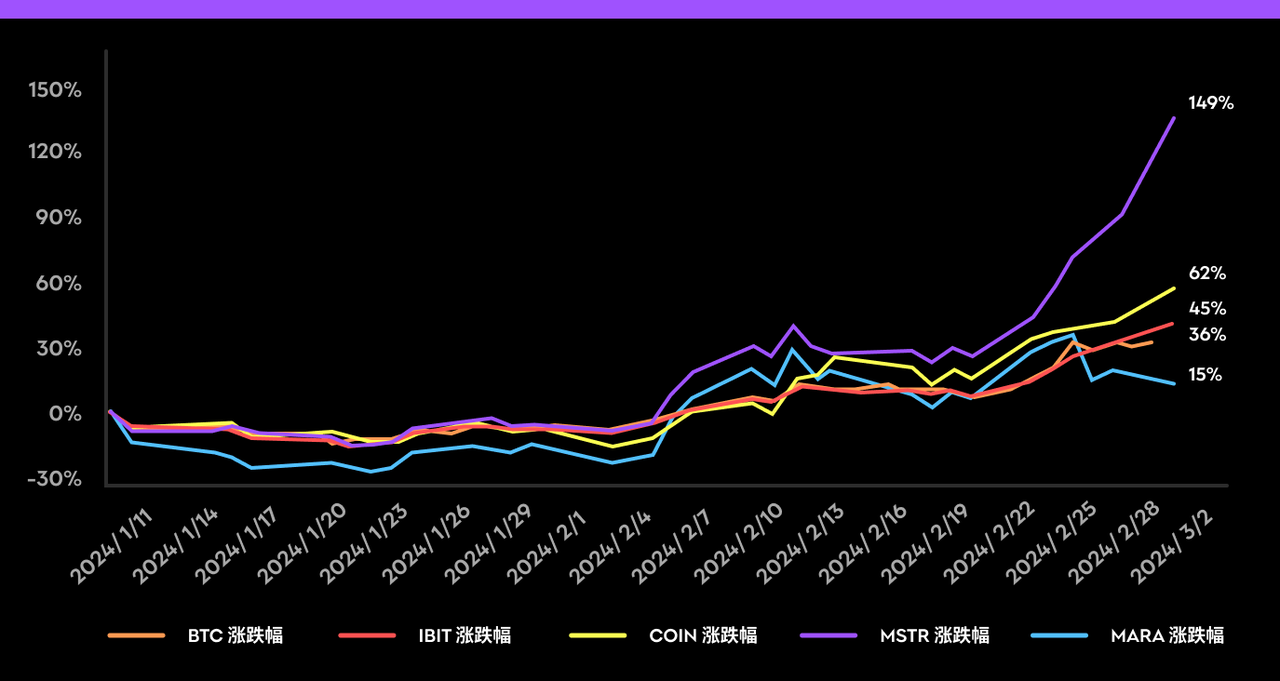
RockFlow 연구팀은 이번 불장에서 암호화폐 거래, 비트코인 자산 관리, 비트코인 채굴의 세 가지 방향을 대표하는 최고 기업들 - 코인베이스, 마이크로스트래티지, 마라톤 디지털 - 이 비트코인 자체보다 더 나은 성과를 보일 것이라고 믿습니다. 그들은 더 큰 유연성, 더 나은 위험 대비 수익률, 더 높은 수익 수준을 가져올 것입니다.
2023년 암호화폐 불장으로 가는 길
2023년 비트코인에는 세 가지 주요 촉매제가 있었습니다.
첫 번째 촉매제는 3월 10일 실리콘 밸리 은행의 붕괴로 촉발된 은행 위기였으며, 이는 전통적인 금융 대안으로서 비트코인에 대한 사람들의 관심을 증가시켰습니다. 그날 비트코인 가격은 20,100달러를 초과했습니다. 한 달 후인 4월 11일, 비트코인 가격은 30,200달러였으며, 위기가 시작된 이후 50% 상승했습니다.
비교하자면, 코인베이스, MSTR, 마라, 라이엇, 클린스파크와 같은 암호화폐 개념 주식은 각각 31%, 73%, 93%, 134%, 49% 상승했습니다. 아래 표는 이를 보여줍니다:

두 번째 촉매제이자 2023년 비트코인의 가장 큰 촉매제는 2023년 6월 15일 블랙록이 미국 SEC에 비트코인 현물 ETF 신청을 제출한 것이었습니다. 이 뉴스는 빠르게 시장을 휩쓸었으며 전통적인 금융 산업이 던진 올리브 가지로 인정받았습니다. 이것에 자극받아 비트코인 가격은 6월 15일 25,500달러에서 7월 14일 30,300달러로 19% 상승했습니다.
이 기간 동안 코인베이스, MSTR, 마라, 라이엇, 클린스파크의 주가는 각각 94%, 65%, 93%, 92%, 66% 상승했습니다.

세 번째 촉매제는 2023년 10월 23일 DTCC 웹사이트에 나타난 블랙록 ETF 코드였으며, 이는 ETF의 잠재적 승인에 대한 추측을 불러일으켰습니다. 결과적으로 비트코인 가격은 10월 23일 33,000달러에서 11월 24일 37,700달러로 빠르게 14% 상승했습니다. 한편 코인베이스, MSTR, 마라, 라이엇, 클린스파크의 주가는 각각 50%, 38%, 30%, 24%, 31% 상승했습니다.

세 가지 주요 사건의 연속적인 부양은 마침내 FTX 사건이 가져온 암호화폐 시장의 차가운 겨울과 어둠을 제거했습니다. 비트코인 가격 상승과 함께 암호화폐 불장이 공식적으로 도래했습니다.
역사를 거울로 삼아, 2024년 가능한 반감기 시장
비트코인 현물 ETF 승인은 중요한 시점이지만, 분명히 끝은 아닙니다. 2024년 4월 19일, 암호화폐 시장은 또 다른 주요 사건을 맞이할 것입니다 - 비트코인의 네 번째 반감기이며, 블록 보상은 6.25 비트코인에서 3.125로 감소할 것으로 예상됩니다.
역사적으로 블록 보상을 반감하면 전후 1년 동안 비트코인 가격에 큰 변동이 발생합니다.

첫 번째 비트코인 반감기는 2012년 11월 28일에 발생했으며, 당시 비트코인 가격은 12달러였습니다. 반감기 전년도 비트코인 가격은 3달러였으며, 이는 비트코인이 이 기간 동안 300% 상승했음을 의미합니다. 이 강한 상승 추세는 반감기 이후 1년 동안 계속되었습니다. 2013년 11월 28일, 비트코인 가격은 1,016달러였으며, 이는 비트코인이 반감기 이후 8,367% 상승했고 반감기 전년도 이후 33,767% 상승했음을 의미합니다.
2016년 7월 9일에 발생한 두 번째 반감기에서도 동일한 추세를 볼 수 있습니다. 그날 비트코인 가격은 647달러였으며, 2015년 7월 9일 268달러와 비교하면 비트코인이 반감기 기간 동안 141% 상승했음을 의미합니다. 비트코인 가격은 반감기 이후 계속 상승하여 2017년 7월 9일(반감기 1년 후) 2,491달러에 도달했습니다.
2020년 5월 11일에 발생한 세 번째 반감기 동안 유사한 상승 추세가 확인되었으며, 당시 비트코인 가격은 8,563달러였으며, 1년 전 7,232달러에서 18% 상승했습니다. 그 이후 비트코인 가격은 2021년에 계속 상승하여 2021년 5월 11일 56,000달러 이상에 도달했으며, 반감기 이후 561% 증가했습니다.
다가오는 네 번째 비트코인 반감기 동안 이 추세가 계속될까요? 매우 가능성이 높습니다. 2023년 4월 19일 비트코인 가격은 약 29,000달러였으며, 2024년 3월 초에는 이미 66,000달러를 초과했으며, 127% 이상 증가했습니다. 이전 속도를 따르면, 비트코인은 2024년 말까지 10만 달러를 돌파할 가능성이 높습니다.
BTC를 능가한 세 가지 미국 주식 목표
현재 전 세계 비트코인 기반 투자 상품(선물 및 현물 ETF 등)이 관리하는 자산 가치는 100만 비트코인(약 640억 달러)을 초과하여 전통적인 금융 시장의 암호화폐 투자 포트폴리오에 대한 관심 증가를 강조하고 있습니다.
K33 Research에 따르면, 100만 비트코인 중 83% 이상이 미국 현물 및 선물 ETF가 보유하고 있으며, 그 다음은 유럽과 캐나다의 투자 상품입니다. 3월 4일 마감 기준으로, 그들은 총 1,008,436 비트코인을 보유하고 있으며, 이는 비트코인 유통 공급량의 5.13%를 차지합니다.
블랙록의 IBIT를 예로 들면, 자산 관리 규모는 단 7주 만에 100억 달러를 초과했으며, 피델리티의 FBTC 펀드 자산은 115,000 비트코인(75억 달러 상당)을 초과했습니다. 전통적인 ETF와 비교하면, 그들의 확장 속도를 이해할 수 있습니다: 현재 3,400개의 ETF 중 약 150개만 자산 관리 규모가 100억 달러를 초과하며, 그 중 대부분은 10년 이상 출시되었습니다.
이러한 투자 도구는 비트코인의 원래 시장 구조를 크게 흔들었습니다. 몇 년 전 현물 거래소가 보유한 비트코인의 유통 공급량은 20%였습니다. 이제 이 숫자는 11%로 하락했으며, ETF/ETP 및 비트코인 기반의 기타 다양한 파생 상품의 규모가 빠르게 확장하고 있습니다.
비트코인이 레버리지 담보로 거래소에 저장되었던 이전과 달리, 이번에는 전통적인 자산 관리 상품이 시장에 진입하여 비트코인 투자 장벽을 크게 낮췄습니다(이전에는 연금 펀드가 비트코인 현물을 구매할 수 없었지만, 이제는 ETF를 구매할 수 있습니다). 동시에 구매한 비트코인은 수탁자 손에 저장되며 시장 조성자에게 담보로 제공되거나 대출할 수 없어 유동성 과잉을 생성하기 어렵습니다.
비트코인이 2024년에 불장을 맞이할 것이라고 믿는다면, 어떤 주식이 가장 큰 혜택을 받을까요? 비트코인과 비교하여 어떻게 성과를 내며, 그들의 펀더멘털과 투자 논리는 무엇일까요? 다음으로 RockFlow 투자 연구팀은 암호화폐 거래, 비트코인 자산 관리, 비트코인 채굴의 세 가지 방향의 최고 기업들 - 코인베이스, MSTR, 마라 - 의 투자 전망을 자세히 분석할 것입니다.
또한 비트코인 대신 암호화폐 주식을 보유하는 또 다른 장점은 투자자가 더 낮은 위험에 직면한다는 것입니다. 비트코인을 직접 보유하는 것은 해킹, 사기, 암호화폐 지갑 및 거래소 실패와 같은 위험을 수반합니다. 전형적인 예는 2022년 말 FTX의 붕괴로, 고객이 89억 달러의 암호화폐 자산을 잃었습니다.
코인베이스
2월 15일 코인베이스는 2023년 4분기 예상을 크게 뛰어넘는 재무 보고서를 발표했으며, 이후 몇 주 동안 주가가 거의 30% 급등했습니다. 이 분기 보고서는 암호화폐 시장의 광범위한 회복으로 인해 코인베이스의 펀더멘털이 개선되고 있음을 투자자들에게 확신시켰습니다. 미국 SEC의 비트코인 현물 ETF 승인으로 비트코인 가격 상승은 투자자들의 암호화폐 시장에 대한 신뢰를 더욱 강화했습니다. 코인베이스는 번성하는 암호화폐 경제 발전에 대한 최고의 베팅이 되었습니다.
실제로 미국 SEC가 비트코인 ETF에 대해 긍정적인 결정을 내릴 것이라는 기대는 이미 2023년 4분기에 암호화폐의 일반적인 상승을 이끌었으며, 이는 코인베이스의 거래 수익 급증에도 반영되었습니다. 암호화폐 가격 상승에 끌려 기관과 개인 투자자들이 이 추세에 합류하여 코인베이스의 2023년 4분기 거래 수익이 전년 대비 64% 급증했습니다. 기관 거래 수익은 전분기 대비 160% 증가했으며, 개인 고객 거래 수익은 전분기 대비 79% 증가했습니다.
또한 2022년 이후 코인베이스의 수익은 더욱 다각화되었으며 예측 불가능한 거래 수익에 대한 의존도를 줄이기 위해 노력하고 있습니다. 코인베이스의 구독 및 서비스 수익은 크게 성장했습니다(전년 대비 78% 증가), 2023 회계연도까지 14억 달러에 도달했습니다. 이러한 서비스에는 블록체인 보상, 수탁 서비스, 고객 대출 이자 수익, 스테이블코인 발행자 수수료가 포함됩니다.
2023 회계연도에서 순이익의 48%는 거래와 무관한 서비스에서 나오며, 2022 회계연도에서는 이 비율이 25%에 불과했습니다. 이러한 다각화는 코인베이스의 미래 수익 변동성을 줄이는 데 도움이 되며 더 안정적인 수익성도 가져옵니다.
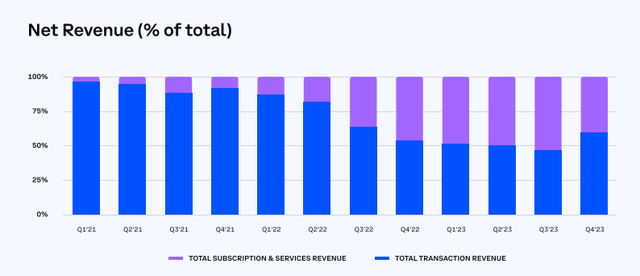
한편 코인베이스의 운영 비용 대폭 감소가 효과를 내기 시작했습니다. 지난 암호화폐 약세 시장 동안 코인베이스는 대량의 직원을 해고하고 비용을 크게 줄였습니다. 오늘날의 코인베이스는 훨씬 더 효율적인 회사이며, 2023 회계연도의 운영 비용은 전년 대비 45% 감소했습니다.
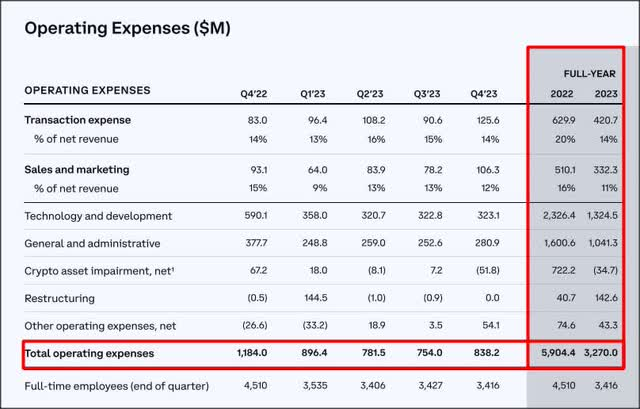
현재 코인베이스는 수익성 있고 안정적인 암호화폐 거래 플랫폼이 되었습니다. 미국 SEC의 비트코인 현물 ETF 승인은 비트코인 거래 수요를 직접 자극했으며, 투자자 정서 부양에 큰 기여를 했고, 전체 암호화폐 경제를 더욱 합법화했습니다.
그러나 코인베이스가 완전히 위험 없는 것은 아니라는 점을 지적해야 합니다. 투자자는 규제 동향, 암호화폐 시장의 순환적 변동, 기타 거래 플랫폼의 파산 위험에 주의를 기울여야 합니다. 2022년 FTX의 파산은 투자자들에게 매우 부정적인 영향을 미쳤으며, 유사한 사건이 암호화폐 시장의 강세 정서를 다시 한 번 심각하게 손상시킬 수 있습니다.
마이크로스트래티지
마이크로스트래티지(MSTR)는 원래 BI(비즈니스 인텔리전스) 및 분석 소프트웨어 서비스 제공업체였습니다. 물론 그들은 여전히 관련 사업을 하고 있으며 최근 AI 분야에 진입했습니다. 하지만 그 진정한 가치는 무엇일까요? 거의 20만 비트코인을 보유하고 있습니다.
MSTR은 비트코인에 "투자"하고 장기적으로 보유하기로 선택했으며, 이는 비트코인과 같은 변동성이 큰 자산의 포트폴리오를 구축하는 최고의 방법 중 하나입니다. 이 방법은 현재 암호화폐 불장에서 엄청난 수익을 가져오고 있습니다.
MSTR의 비트코인 구매 움직임은 2020년 8월에 시작되었으며, 세 번째 비트코인 반감기 이후 약 3개월 후였습니다. 첫 구매 후 약 1년 후, MSTR의 비트코인 보유량은 92,000으로 급증했습니다. 회사는 현재 193,000 비트코인을 보유하고 있으며, 현재 가격 기준으로 130억 달러 이상의 가치이며, 미실현 이익은 60억 달러입니다.
비트코인을 구매하기 위해 지속적으로 채권을 발행하기 때문에 2020년 이후 MSTR 주가와 비트코인 가격은 강한 상관관계를 보여왔습니다. 역사적 데이터는 MSTR 주가가 비트코인 가격 변동을 효과적으로 증폭시킬 수 있음을 보여줍니다. 평균적으로 MSTR의 변동 수준은 비트코인 가격의 1.5배입니다.
따라서 비트코인의 시장 후 성과에 대해 낙관적이라면, MSTR을 사용하여 비트코인 상승을 초과하는 초과 수익을 얻을 수 있습니다.
그러나 비트코인 가격의 지속적인 변동성 위험을 고려할 때, MSTR 주가도 더 큰 변동성을 감수해야 한다는 점을 지적해야 합니다. 지정학적 긴장이나 거시경제 충격을 포함한 예상치 못한 글로벌 사건은 암호화폐 시장에 영향을 미칠 수 있으며, 따라서 MSTR에도 영향을 미칠 수 있습니다.
마라톤 디지털
거시경제 조건의 개선과 비트코인 가격의 지속적인 급등으로 인해 비트코인 채굴 주식은 지난 몇 달 동안 상당한 수익을 달성했습니다. RockFlow 연구팀은 마라톤 디지털(마라)이 모든 비트코인 채굴 주식 중 최고의 목표라고 믿습니다. 그 이유는 그들의 컴퓨팅 파워와 비트코인 보유량이 경쟁자들을 초라하게 만들기 때문입니다. 마라는 투자자에게 더 유연한 거래 기회를 제공하며, 비트코인이 올해 반감기 이후 계속 새로운 최고치에 도달할 수 있다는 점을 고려할 때 마라도 기대할 만합니다.
선도적인 비트코인 채굴 회사로서 마라의 전략은 운영 비용을 지불한 후 비트코인을 채굴하고 장기 투자로 보유하는 것입니다. 현재 마라는 미국, 아부다비, 파라과이의 합작 투자를 통해 비트코인을 채굴합니다. 비록 일부 광산이 이전에 제3자 수탁에 위탁되었지만, 이 모델을 포기하고 있으며, 이는 채굴 비용을 줄이고 운영 효율성을 향상시키는 데 도움이 됩니다.
앞서 언급했듯이, 반감기 사건은 종종 비트코인 가격에 극도로 긍정적인 영향을 미치지만, 비트코인 채굴 주식에 대한 영향은 동일하지 않습니다.
블록 보상의 반감으로 인해 기본적으로 채굴 비용이 두 배가 되었습니다. 따라서 채굴 주식은 생산의 예상 감소를 보상하기 위해 반감기 이후 비트코인 가격 상승에 크게 의존합니다. 이러한 이유로 자본 보유가 부족한 채굴 회사는 계속하기 어려울 수 있지만, 선도 기업은 모든 것을 차지할 가능성이 더 높습니다.
마라가 채굴 주식의 승자가 되는 것에 대해 낙관적인 이유는 무엇일까요? 이유는 다음과 같습니다:
마라의 첫 번째 장점은 비트코인 보유량입니다. 현재 마라는 채굴 회사 중 가장 큰 비트코인 보유량을 보유하고 있으며, 15,741 비트코인을 보유하고 있습니다. 대조적으로, 가장 큰 경쟁자인 라이엇과 클린스파크는 각각 7,648 및 3,573 비트코인을 보유하고 있습니다. 즉, 비트코인 가격 상승은 마라에게 가장 큰 혜택을 줄 것입니다.
마라의 두 번째 장점은 경쟁사 대비 컴퓨팅 파워입니다. 현재 마라의 배포된 컴퓨팅 파워는 26.7 EH/s로, 라이엇과 클린스파크보다 높습니다(후자는 1월에 각각 12.4 및 10.09 EH/s를 보유했습니다). 마라는 올해 말까지 컴퓨팅 파워를 34.7 EH/s로 증가시킬 것으로 예상합니다. 라이엇은 4분기에 컴퓨팅 파워를 28.8 EH/s로 증가시킬 것으로 예상합니다. 클린스파크는 올해 상반기에 컴퓨팅 파워가 20 EH/s에 도달할 것으로 예상하며, 최근 샌더스빌 확장을 완료한 후 16 EH/s 이상에 도달했습니다. 더 높은 컴퓨팅 파워 수준으로 마라는 반감기 이후 더 많은 비트코인을 지속적으로 생산할 수 있는 능력이 더 높습니다.
마라의 세 번째 장점은 현금 보유량입니다. 1월 데이터에 따르면, 마라의 현금 잔액은 3억 1,900만 달러로, 라이엇의 2억 9,000만 달러와 클린스파크의 1억 7,300만 달러를 초과합니다. 더 풍부한 탄약은 마라가 반감기 이후 생존하지 못할 수 있는 비트코인 채굴자 인수를 늘리고, 더 많은 채굴자를 구매하거나 새로운 시설을 구매하는 것을 포함하여 더 많은 성장 기회를 탐색하는 것을 명확히 지원합니다.
그러나 마라도 특정 위험이 있습니다. 첫 번째는 지속적인 주식 발행이며, 유통 주식 수는 2022년 1분기 1억 630만 주에서 2023년 3분기 2억 2,260만 주로 증가했으며, 거의 110% 증가했습니다. 이것은 주가에 부정적인 요인입니다.
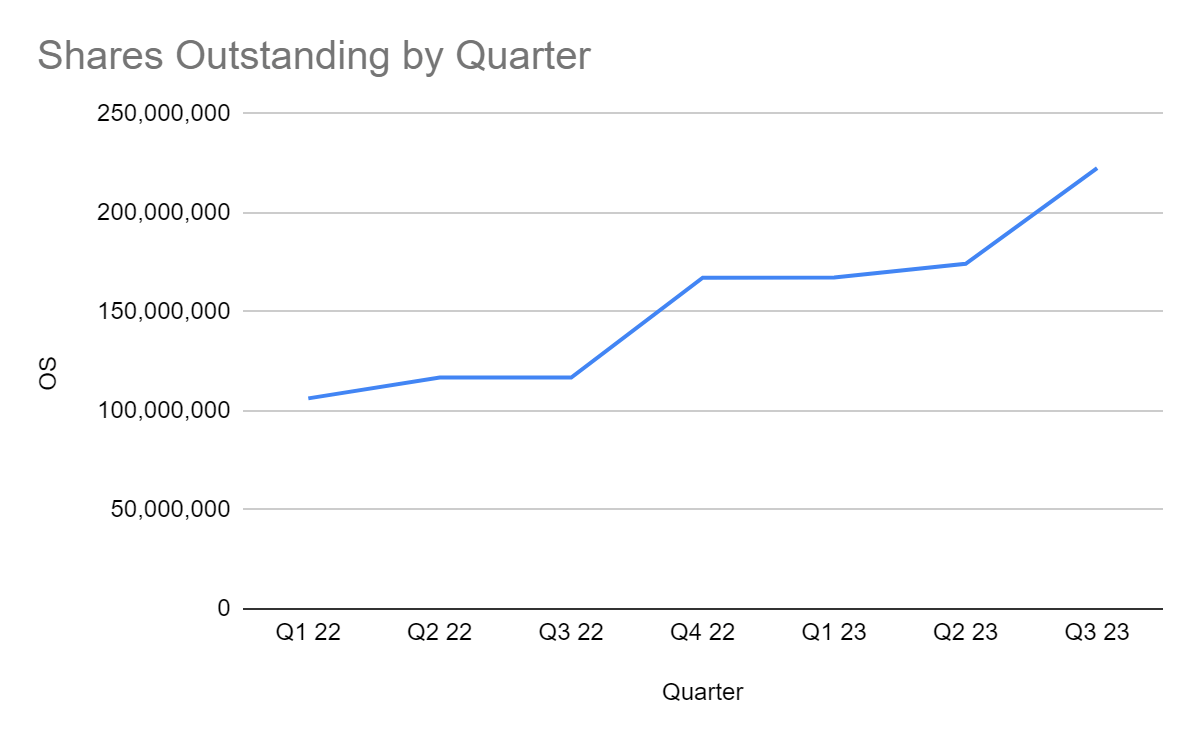
더 중요한 위험은 비트코인 자체에서 옵니다. 마라 주가 상승의 전제는 비트코인이 계속 평가절상된다는 것입니다. 반감기 이후 비트코인 가격이 크게 상승하지 않거나 다른 예상치 못한 사건으로 인해 하락하면, 마라는 곤경에 처할 것입니다.
결론
수십 개의 비트코인 ETF가 승인된 이후, 비트코인과 비트코인 ETF의 가격은 2개월도 안 되어 40% 상승했습니다. 4월에 다가오는 반감기 사건과 비트코인 가격을 상승시킨 역사적 변동성을 고려할 때, RockFlow 연구팀은 비트코인 가격이 올해 계속 상승할 것이라고 믿습니다.
코인베이스, MSTR, 마라는 각 분야의 고품질 목표로서 이번 시장 추세에서 비트코인에 대한 훌륭한 대안입니다. 그들은 투자자에게 더 큰 유연성, 더 나은 위험 대비 수익률, 더 높은 수익 수준을 가져올 것입니다.